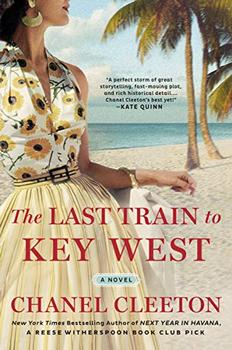Summary | Excerpt | Reading Guide | Reviews | Beyond the Book | Read-Alikes | Genres & Themes | Author Bio

This article relates to The Last Train to Key West
 Chanel Cleeton's historical novel The Last Train to Key West is based on a real event that took place on September 2, 1935, now known as the Labor Day Hurricane (and sometimes called the Labor Day Storm), a Category 5 storm that killed between 400 and 600 people in the Florida Keys. It was the first recorded Category 5 hurricane to hit the United States.
Chanel Cleeton's historical novel The Last Train to Key West is based on a real event that took place on September 2, 1935, now known as the Labor Day Hurricane (and sometimes called the Labor Day Storm), a Category 5 storm that killed between 400 and 600 people in the Florida Keys. It was the first recorded Category 5 hurricane to hit the United States.
The Labor Day Hurricane began as a tropical storm that was detected east of the Bahamas on August 29. The storm moved past Andros Island, an archipelago in the Bahamas, on September 1. As it turned in the direction of the Keys, it rapidly became more powerful, and by the time it reached the Middle Keys on September 2, it had attained Category 5 strength. The hurricane produced peak winds of 200 mph, and devastated the Keys as it struck, leveling structures and trees. It destroyed most of Islamorada, a village spanning five islands. While it isn't known exactly how all victims of the storm were killed, it is thought that most of those caught in the storm's path drowned, and that some died of "sandblasting," or from being hit forcefully by sand and wind traveling at high speeds.
Henry Flagler's Overseas Railroad, an extension of the Florida East Coast Railway that connected Key West to the mainland, was destroyed by the Labor Day Hurricane. Construction of an Overseas Highway was underway at the time, and about 260 of the people who died in the storm were World War I veterans who had been dispatched to the Keys for relief work by the Works Progress Administration established by President Franklin D. Roosevelt. A train had been sent to rescue workers who were living in camps on Lower Matecumbe Key, and was swept off the tracks by storm surges. The Overseas Railroad was never rebuilt, but the Overseas Highway was later completed and is now part of U.S. Route 1.
In a magazine article, writer Ernest Hemingway, who had a home in the Keys, harshly criticized the decision to send workers to the area during hurricane season, asking pointed questions such as, "Who sent them down to the Florida Keys and left them there in hurricane months? Who is responsible for their deaths?" While claiming not to have specific answers to these questions, Hemingway was clearly calling attention to the role of the U.S. government in the veterans' deaths and accusing the government of not valuing the lives of working-class people. Aside from drawing attention to this specific incident, his article highlighted concerns about class lines and raised discussion around inequality.
The Labor Day Hurricane remains one of the strongest hurricanes to ever make landfall in the U.S. The Florida Keys Memorial, a monument to the "Great Hurricane," which includes a crypt to hold victims' ashes, was erected in Islamorada in 1937 and added to the United States National Register of Historic Places in 1995.
Filed under People, Eras & Events
![]() This article relates to The Last Train to Key West.
It first ran in the June 24, 2020
issue of BookBrowse Recommends.
This article relates to The Last Train to Key West.
It first ran in the June 24, 2020
issue of BookBrowse Recommends.






Your guide toexceptional books
BookBrowse seeks out and recommends the best in contemporary fiction and nonfiction—books that not only engage and entertain but also deepen our understanding of ourselves and the world around us.